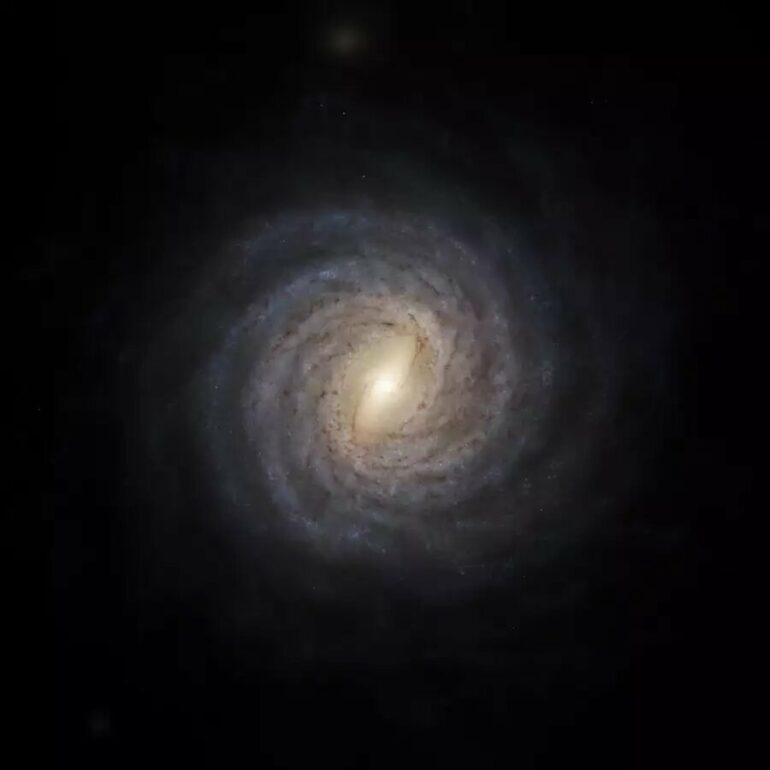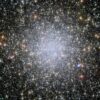Researchers have reconstructed what alien astronomers observing our Milky Way galaxy from afar would find if they analyzed our home galaxy’s chemical composition. The study, which is led by researchers from the Max Planck Institute for Astronomy, is relevant for our own understanding of the cosmos: It allows for a new kind of comparison between our home galaxy and the many distant galaxies that we observe from the outside. The results provide part of the answer to the old question whether our home galaxy is special: at least when it comes to chemical composition, the Milky Way is unusual, but not unique.
We see distant galaxies from the outside: Telescope observations show us a galaxy’s shape and its spectrum (the rainbow-like decomposition of a galaxy’s light). So how would our own galaxy look from that perspective, to a distant, alien astronomer? That is a deceptively simple question. After all, astronomers here on Earth have devised quite ingenious ways of deducing a galaxy’s properties from what we observe, and alien astronomers will likely have a similarly sophisticated view of the Milky Way.
For the more sophisticated methods of analysis, it is not at all easy to tell what alien astronomers would find, were they to apply those methods to our home galaxy. But the pay-off can be considerable. Jianhui Lian (Max Planck Institute for Astronomy and Yunnan University), the lead author of the study that has now been published in Nature Astronomy, says, “Finding ways to compare our home galaxy with more distant galaxies is what we need if we want to know whether the Milky Way is special or not. This has been an open question since astronomers realized a hundred years ago that the Milky Way is not the only galaxy in the universe.”
Great strides for data and simulations
As old as the question may be, it looks like astronomy is right now in a good position to find a solid answer. For one, in the past decade or so, there has been tremendous progress in systematic studies of our home galaxy. There have been surveys, such as APOGEE, providing information about the chemical composition, physical properties and 3D motions of millions of individual stars in our Milky Way deduced from their spectra. ESA’s Gaia spacecraft has tracked the brightness, motion and distance for nearly 1.5 billion stars in our home galaxy.
There is also much more and much better data for distant galaxies. The MaNGA survey studied nearly 10,000 galaxies in depth. Where previous surveys targeting that many galaxies would only provide one overall spectrum per galaxy, MaNGA paints a “spectral picture,” showing how, say, each galaxy’s chemical composition varies from the center to the outer regions.
Last but not least, there are now modern simulations of galaxy formation and evolution, like the TNG50 simulation that follows the history of thousands of galaxies in a model universe from after the Big Bang to the present time. All these developments where necessary for us to predict what alien astronomers would see as they pointed their telescopes towards the Milky Way and attempted to reconstruct the galaxy’s chemical composition.
Second-guessing alien astronomers
This is just what a new study led by Lian and Maria Bergemann (Max Planck Institute for Astronomy) did. Specifically, Lian, Bergemann and their colleagues considered the chemical composition of stars. The stars we see around us consist mostly of hydrogen and helium, but there is a smattering of elements heavier than helium—elements that, in astronomy (but not in ordinary chemistry!) are called “metals.”
Some of these metals are produced inside stars, and flung into space when massive stars explode at the end of their lives. Others are produced in the outer layers of bloated giant stars, and set to drift out into space from there. And most importantly, there is a general trend: The concentration of metals in the interstellar medium—the low-density mix of gas and dust that fills the space between the stars—increases over time. Stars that were born earlier contain fewer metals, later-born stars contain more. Mapping out which regions of a galaxy has stars with fewer or with more metals tells you which region formed its stars earlier and which region later.
From local cosmology to an alien perspective
Our home galaxy, the Milky Way, is currently the only spiral galaxy in which we can directly make a large-scale survey of individual stars—measure their positions within our galaxy and, via their spectra, their metal content, surface temperature and other physical properties. Lian, Bergemann and their colleagues set out to reconstruct what alien astronomers would see if they were to map the prevalence of metals in the Milky Way. Since our home galaxy is a disk galaxy, the key question is: How would a distant alien astronomer see the abundance of metals vary depending on the distance of a region from the center of our galaxy?
This kind of reconstruction takes work. The data from the APOGEE survey was only the starting point. Next, the researchers needed account for the fact that, from Earth, we have a “smudgy” view of the Milky Way: In some directions, there will be more dust between us and more distant stars, attenuating the star light and hiding some of the dimmest stars altogether. In other directions there will be less dust. The researchers needed to combine the observation data with what we know about dust and about the properties of stars in order to reconstruct the real distribution of stars in our galaxy.
Our galaxy’s high-metallicity ‘belt’
The results were somewhat surprising. If you track the average metal content of stars from the galaxy center outwards, it will increase, reaching a metal content close to that of our sun at a distance of about 23,000 light-years from the center. (For comparison: our sun is at about 26,000 light-years from the galactic center.) At an even greater distance, the average metal content goes down again, dropping to roughly one third of the solar value at around 50,000 light-years from the center.
In order to understand what was going on, the researchers then looked separately at stars of different age groups—the APOGEE spectra allow for at least a rough estimate of stellar age. Looking at younger and older stars separately, they found that each age group basically followed an unbroken trend with higher metal content closer to the center, lower content further out. The increase and maximum of the overall distribution was purely due to older stars (with much lower metal content) being more abundant near the galactic center and thus pulling down the overall average, but with younger stars becoming more frequent further out.
Comparing our Milky Way with other galaxies
Lian, Bergemann and their colleagues compared this interesting result with the properties of other galaxies. On the one hand, they considered 321 galaxies in the MaNGA survey, all of which have masses similar to the Milky Way, produce similar amounts of stars and all of which are visible face-on, so the change of average metallicity could be measured. On the other hand, the researchers used the same criteria to identify 134 Milky-Way-like galaxies in the model universe of the TNG50 simulation.
So just how special is our home galaxy—or not? The answer provided by the present study: When it comes to the distribution of metal abundances, our Milky Way is unusual, but not unique. Only 11% of the galaxies in the TNG50 sample and about 1% galaxies in the MaNGA sample showed a similar up-and-down of average metallicity. The discrepancy between 11% and 1% is likely to be due to a combination of uncertainties in the MaNGA data and the limitation of realistic simulations in the TNG50 model universe.
In addition, in the outer regions, the decrease in average metallicity with increasing distance from the center is rather more steep for the Milky Way, compared with the MaNGA and TNG50 galaxies.
The question of ‘why’
So why does the Milky Way have the unusual properties it has, and what do these properties mean for our home galaxy’s formation history? There are several ways of explaining comparative scarcity of metal-rich stars near the galactic center. This feature could be related to the formation of the so-called bulge, a roughly spherical region of older star surrounding the galactic center out to distance of about 5,000 light-years. Bulge formation would have used most of the available hydrogen gas, making later star formation much more difficult. Alternatively, the scarcity could be related to an active phase in which our galaxy’s central supermassive black hole spewed out particles and radiation from its immediate neighborhood, inhibiting star formation.
The metallicity in the outer regions can be explained by several scenarios that combine the evolution of gas within our home galaxy with the history of star formation across the galactic disk. The steep decline could be the sign of an unusual episode in our galaxy’s history—say, our home galaxy “swallowing” a smaller galaxy with gas that contained very few metals. That gas would later on have served as raw material for the formation of stars with fewer metals in the disk. It is also possible that our estimate for the extent of the stellar disk of the Milky Way is off, and that that this error skews the comparison with other galaxies when it comes to how steep the decrease is.
Outlook
Maria Bergemann says, “The findings are very exciting! This is the first time that we can meaningfully compare the detailed chemical content of our galaxy with the measurements of many other galaxies. The results are important for the next generation of comprehensive studies of galaxy formation. Those studies will use data from upcoming large-scale observational programs targeting the Milky Way or targeting distant galaxies. Our research shows how to sensibly combine the two kinds of data set.”
All in all, the research described here raises a number of interesting questions. With new surveys, and new studies that explore an “alien astronomer” perspective, we can hope to find answers, and to better understand our home galaxy’s history in the process.
More information:
Jianhui Lian et al, The integrated metallicity profile of the Milky Way, Nature Astronomy (2023). DOI: 10.1038/s41550-023-01977-z
Provided by
Max Planck Society
Citation:
Reconstructing an alien astronomer’s view of our home galaxy’s chemistry (2023, June 26)



